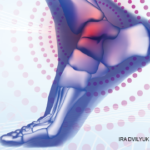Margaret meandered slowly down the corridor. She wasn’t lying: She really walked as though she were drunk. This reminded me of a clinical pearl taught to me by a wonderful, old-school neurologist who loved examining patients: If the patient walks like a drunk but hasn’t had a drink, focus on their cervical spinal cord.
Margaret’s fluttering ankle jerks and pathologic dorsiflexion of her big toes confirmed this adage to be true. It turned out that an old problem unrelated to her RA had resurfaced. Imaging studies confirmed the presence of very severe cervical spinal cord compression caused by the architectural changes imparted by her longstanding cervical spondylosis. Unlike severe peripheral neuropathy, which is generally resistant to treatment, cervical myelopathy can sometimes be remedied by surgery.
My other new patient, Cindy, was a delightful, upbeat nanny who seemed to be struggling with her RA. Although her peripheral arthritis seemed to be under reasonable control, she was frustrated by her declining ability to walk, a rather dire situation for an active 43-year-old woman. She kept experiencing episodes in which her arms and legs “went numb.” Although she rarely fell, this eerie sensation would halt her in her tracks.
I was stumped when I met Cindy. Her neurologic function was intact, and there were no obvious clues. She came armed with a Google search of her symptoms, which concluded that she might be developing multiple sclerosis. It was a reasonable consideration for a patient being treated with a tumor necrosis factor inhibitor who was experiencing recurrent, widespread neurologic symptoms.
The magnetic resonance imaging (MRI) study of her brain was striking. The brainstem, that precious piece of matter whose simple name belies its preeminence, was being impinged by her occiput. A severely damaged atlanto-axial joint, whose normally taut ligaments had been shredded by the adjacent mass of inflammatory rheumatoid pannus, precipitated this worrisome sequence of events. Now Cindy’s upper neck was free to jab the base of her skull. In essence, her atlas was dropping the ball or, shall we say, her head.
The generally sturdy and reliable C-1 vertebra, the atlas, was named for the primordial titan whose punishment for being disloyal to the Greek god Zeus was to carry the heavens on his shoulders forever. In healthy individuals, it carries our heads fairly effortlessly. Needless to say, a few millimeters of tissue shifting in this highly sensitive area can make all the difference between capacity and incapacity.1
